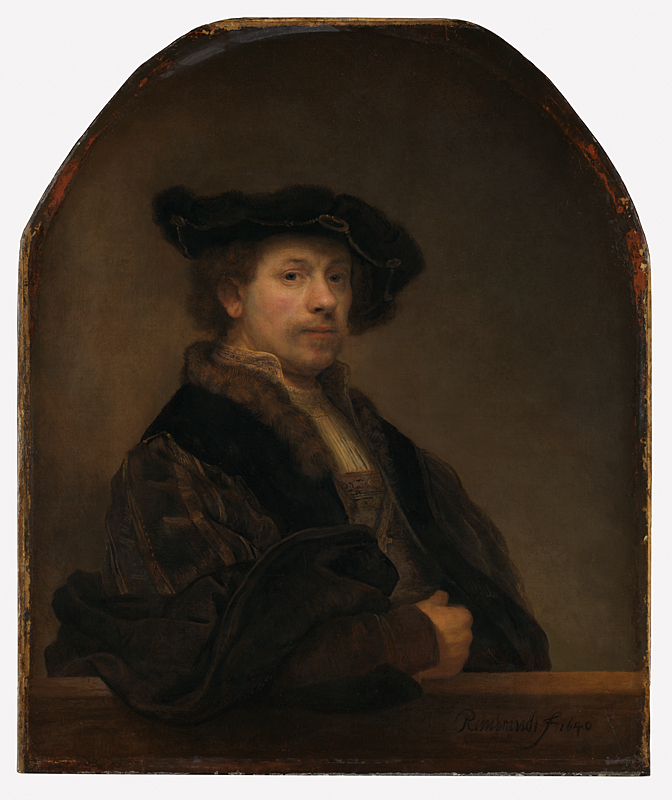Rembrandt in Brighton at Brighton Museum & Art Gallery
10 May to 4 August 2024

Earlier this year I posted the following advice to painters on my Painting Studio Strategies Instagram account: ‘Paintings must be seen for real’. Of course, it’s an obvious thing to say, but we all (not only painters) should see actual works whenever possible. The obvious reasons for looking at a painting are straightforward: the viewer sees the work without changes to its size, the colours and tones are not affected by a printed reproduction or the screen settings, the surface qualities are not smoothed out and you can get up close (within reason). But there’s another element, which is subjective and relies on the viewer giving ample time to experiencing the work.
In this instance I imagined the painter (myself included) in the studio surrounded by one’s own paintings with images of other artists’ work, especially our heroes, only being accessed through books or on our iPhone screens. There might be a few postcards on the wall too, although I suspect that card sales have plummeted since the advent of the mobile device and through being allowed to take photographs in most exhibitions for personal use.
When we do see a painting for real, by which I mean one from the greatest of all painters such as Rembrandt, there might be a degree of surprise or just a reminder that paint, most especially oil paint, is an astonishing medium. In the right hands a painted image can move into a region beyond what we might call ‘materiality’ today. The experience of looking might even go beyond ‘subject matter’ too. As I mentioned above, there is surely a subjective aspect to this point of view but I would advise a detractor to visit an institution, such as the National Gallery in London, to tune into the alluring charisma and sublimity of the paint medium. Or maybe just its ordinariness as an ingredient in a composition (I am thinking here of Piero della Francesca) will suffice.
So when a painting by your favourite Old Master is displayed in the local art gallery, just a ten-minute walk from the Phoenix Art Space studio for me, there is no excuse to not visit several times. In fact for the locals we just have to pay once and we can revisit the Brighton Museum and Art Gallery as often as we wish for twelve months. So I expect to pay homage to Rembrandt Harmenszoon van Rijn’s ‘Self Portrait at the age of 34’ (1640) quite a few times up until August this year. The painting is on loan from the National Gallery to celebrate the Bicentenary of one of the most important art galleries in the world. Twelve paintings from the collection are being lent to venues across the UK, which would be a great initiative to continue and to expand to even more galleries for many years to come.
If I try to define the impact of this astonishing self-portrait it’s difficult not to fall into well-worn cliché, particularly in relation to the gaze of the sitter connecting with the viewer, or the implied humanity of engaging with a fellow human being from so far back in time. Then there’s the art historical and cultural information that not unreasonably feeds into the experience of appreciating the painting (see the impressively curated NG website for a full explanation, link below). One could even make a connection, if contemporaneity is sought, to notions of the ‘selfie’ today, although the virtual instaneity of the self-portrait type image made with a smartphone will generally be quite superficial, even facile. Rembrandt’s heavily implied self-confidence and promoting of his painting skills are clearly on display. But this is certainly not a painting that celebrates selfhood or reveals the more modernistic sense of existentiality that questions the times one lives in. The painting is certainly a form of advertising as Rembrandt sought commissions from the wealthy Dutch collectors of the 1640s.
But there’s just something about the paint and its application, and about the control of colour and tonality that Rembrandt fuses so well with the subject beyond appearance. Does the face/head represents thought and ideas, whilst the hand on the parapet in the foreground represents the human hand that physically works in conjunction with the intelligence. Is this a manifesto of sorts that elevates the painter to the realm of the poet? Rembrandt, the painter, achieves a notion of image (visual art) with ideas (expressed through literature, most especially poetry) that we might consider ‘abstract’ – beyond but reliant upon the visual and the written or spoken word*. The indefinable ‘X factor’, to use modern parlance.
On my second visit another viewer commented to her partner, “The more you look the more you see. It’s the detail.” Yes, I thought, but it’s the aura too. This does not seem to be down to skill alone. It’s not purely about the painter’s choice of what to do and how to do it. It’s from a training, and a looking at other artists (Titian in particular) and of having some practical purpose in the subject matter. But more still.
You really have to see it to believe it. And, fellow painter, if you get the chance to visit buy a postcard for just 75p.
Geoff Hands (June 2024)
* This connection of painting with poetry was mentioned by Bart Cornelis, National Gallery Curator of Dutch and Flemish painting, in a public talk connected with the showing of the Rembrandt portrait.
LINKS:
Brighton Museum & Art Gallery
The National Gallery, London
https://www.nationalgallery.org.uk/paintings/rembrandt-self-portrait-at-the-age-of-34
Phoenix Art Space – https://phoenixartspace.org/
Instagram – @painting_studio_strategies
